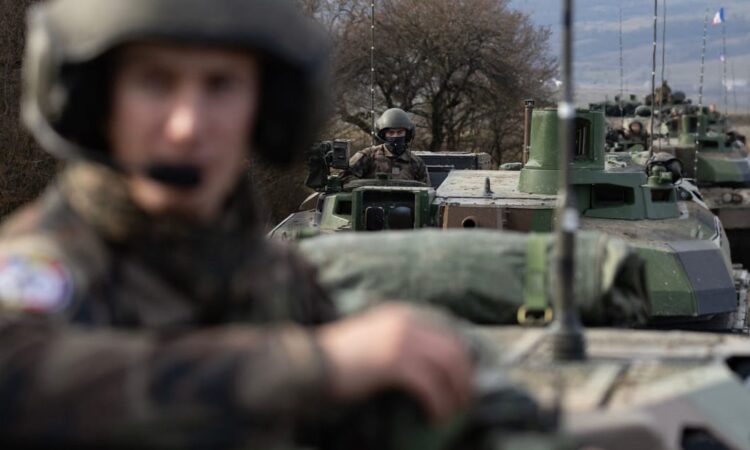
Press play to listen to this article
Voiced by artificial intelligence.
PARIS — French President Emmanuel Macron wants to ramp up military expenditure to €413 billion over the next seven years, but critics say the 30 percent spending boost isn’t taking into account what’s happening on the ground in Ukraine.
The Russian invasion of Ukraine has been marked by a voracious use of artillery and rockets — a return to a more traditional type of warfare that post-Cold War planners had eschewed in favor of smaller, high-tech and highly trained forces able to deploy far from home.
The French military budget — which the National Assembly will begin voting on this week — still sticks to that pre-Ukraine war model by cutting back on heavy weapons like tanks and armored personnel carriers while boosting spending on France’s nuclear deterrent and investing in fighting new threats in areas such as space, cyber and the deep seas.
A final vote is expected before July 14, France’s national day.
“Many people advocated for … more Leclerc battle tanks, more Rafale fighter jets to be able to strengthen NATO’s eastern flank. But that’s not France’s logic,” said Pierre Haroche, a Paris-based defense researcher at London’s Queen Mary University.
According to Michel Goya, a French military consultant and retired army colonel, the new military budget which runs from 2024 to 2030 shows France — the only EU country with nuclear weapons — is not preparing for the possibility of a major land conflict.
“The bottom line is that our nuclear firepower protects us from a Ukrainian scenario. [Instead] we’re trying to project ourselves forward and be capable of joining an air and naval coalition led by the United States,” he said.
France’s choices
Three years of spending public money to alleviate the COVID crisis have left the French government facing high inflation, a budget squeeze and soaring public debt. That’s why it’s favoring its traditional reliance on nuclear forces rather than massively ramping up its conventional strength — a sharp contrast with Poland, a non-nuclear state that borders both Ukraine and Russia and has ambitions to create the EU’s largest conventional military.
In France, the impact can be seen in scaled back procurement plans.
The government had planned to refurbish 200 Leclerc main battle tanks by 2030, but under the new plan that figure falls to 160; Ukraine is also asking France to donate some of those tanks, but Paris hasn’t yet approved such a transfer. The air force was expected to have 185 Rafale fighter jets by 2030, but will only get 137.
France will also aim for 200 Jaguar armored reconnaissance vehicles instead of 300; and about 1,300 Griffon armored personnel carriers instead of over 1,800. The executive branch put forward amendments ahead of this week’s vote committing to buy more Jaguar and Griffon vehicles to replace equipment donated to Kyiv. That effort however won’t be financed by the multiannual budget.
For all armed forces equipment, the original targets are still valid for 2035, the government insists.
“With the international context and war on our doorstep, it’s fine to explain that deterrence is important, but conventional [warfare] matters as well,” said Cédric Perrin, a lawmaker from the conservative Les Républicains party and a vice president of the Senate’s defense and foreign affairs committee.
Delaying equipment for France’s armed forces would also limit the country’s capacity to give weapons to Ukraine, he explained.
Other European countries face similar trade-offs: The United Kingdom — also a nuclear power — is mulling cuts to land forces despite recent hikes in military spending; Germany announced it would embark on a €100 billion Zeitenwende defense budget boost, but most of that money still isn’t allocated.
This may make it difficult for European countries to fulfil NATO’s new target of having 300,000 troops on high alert, setting the Continent up for a continued dependency on the U.S. military.
Looking beyond Ukraine
While Ukrainian President Volodymyr Zelenskyy was in Paris last week to meet Macron — and got a commitment for more weapons and light tanks — the budget looks beyond Eastern Europe to rising tensions between China and the U.S.
“The budget plans reflect a real strategic vision, not short term, but long term. We are thinking about the Indo-Pacific region, about the deep seas,” said Philippe Maze-Sencier, a geopolitics analyst with Hill+Knowlton Strategies. “Who in Europe thinks about that? We’ve got a rare materials problem and we know that the ocean depths have mining resources.”
In the next seven years, France will spend €5 billion to build a new aircraft carrier to replace the Charles de Gaulle.
The multi-annual plan also seeks to tackle what Armed Forces Minister Sébastien Lecornu called “new areas of conflict and militarization” — namely space, the deep seas and cyber. By 2030, Paris wants to invest €6 billion in space, €4 billion in cyber — representing a 300 percent increase — and €5 billion in intelligence services.
“We stand by these choices,” Lecornu told senators in early May. “It is urgent to act, and it’s more important for our collective security than if we delay the delivery of a few Griffon vehicles by a year or two.”
That leaves France trying to balance its traditional ambition to be a global power player against the need to react to the largest conflict in Europe since World War 2 and Macron’s hopes for a stronger Europe that’s more independent of the United States.






